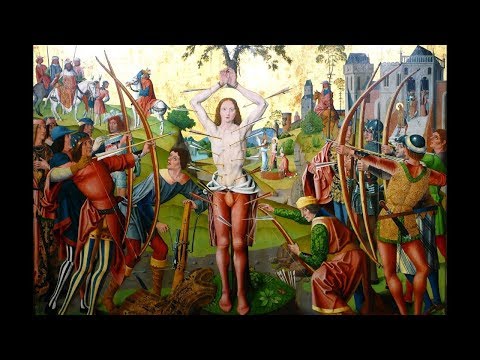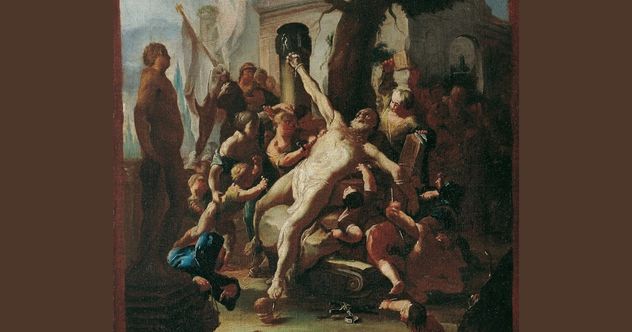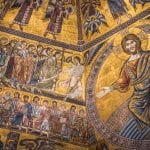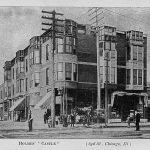In the centuries since, the legends of these saints have grown. Stories of their lives became a popular literary genre in the Middle Ages. Tales of their exploits were spread across the Christian world as inspiration to remain faithful to God. Unfortunately, the accounts also told of the martyrs’ awful deaths. Even today, contemporary historians have documented many terrible stories of how Roman emperors persecuted and brutally murdered early believers. Here are ten of the most shocking and violent acts that sent these timeless saints into martyrdom.
10 Saint Bartholomew Was Flayed and Beheaded
Eleven of Jesus’s twelve Apostles were martyred. Only John, who died of old age, escaped the gruesome fate of those early believers. For the others, including Matthias, Peter, Andrew, and Philip, death came in ways mostly conventional at the time. Most were stoned or crucified. Those are awful ways to die, of course. But these methods were fairly common for Christian believers during those difficult times. However, the twelfth Apostle saw a fate far worse than his counterparts. According to Biblical tradition, during their lives, the Apostles cast their lots to determine who would go where to spread Jesus’s message. Bartholomew was said to have been sent to India to spread the Gospel. It’s unclear whether he ever got that far, though. The most popular historical accounts of his evangelism indicate he ended up in Armenia. There, it was said he converted the nation’s king. Enraged at Christianity’s incursion, local leaders arrested him and sentenced the faithful man to death. But Bartholomew wasn’t just stoned or even crucified. He was flayed alive. Assailants tore the skin off his wounded body before beheading him over his faith. Today, his brutal death lives on in artistic depictions, including a notable work in the Sistine Chapel. In it, Bartholomew is holding his skin like a cape. The powerful image captures his determination to die for his faith. His martyrdom has lived on ever since.[1]
9 Saint Barbara Was (Supposedly) Betrayed by Her Own Father
Saints are often venerated as patrons of different things or groups. For example, Saint Michael the Archangel is the patron saint of soldiers and police. Saint Christopher is the patron saint of travelers. Saint Jude is the patron saint of lost causes. But did you know there is also a patron saint of artillery and cannons? That would be Saint Barbara, who is revered by artillerymen and soldiers worldwide for her supposed acts. In reality, Saint Barbara’s legend may be more myth than fact. Still, it hasn’t stopped adherents from honoring her supposed sacrifice after an awful death. As the story goes, Barbara was the beautiful daughter of a nobleman father named Dioscorus. In her youth, she pledged herself to Christ and swore to remain a virgin. Her pagan father was enraged at that, so he ordered a tower to be built. There, he intended to lock her up until forcing her into a marriage. While the tower was being constructed, Dioscorus ventured into town. When he returned, he was shocked to find Barbara had installed three windows in the structure meant to represent the Holy Trinity. Seeing Barbara’s insistence on following Christ, her frustrated father ordered her execution. Miraculously, she survived several attempts on her life. That only made her dad angrier. So he ordered his own daughter to be tortured. Then, he beheaded her himself. The betrayal marked the end of Barbara’s life and the beginning of her martyrdom. It was the end for her murderous father too. On his way home from the execution, Dioscorus received his comeuppance for killing his daughter. A sudden bolt of lightning incinerated the enraged father, killing him instantly. Ever since, Barbara has rightfully been the patron saint of lightning-like weapons.[2]
8 Saint Sebastian Cheated Death Once, and Then…
Saint Sebastian may be one of the best-known saints because of the lasting nature of his artistic portrayals. As paintings throughout the years have documented, he was shot full of arrows during his life. As he grapples with the mortal wounds, Sebastian’s near-naked body exudes the agony and ecstasy of sacrificing for faith. But Sebastian didn’t actually die from that infamous barrage of arrows. In fact, he survived the notorious attempt on his life only to meet a far worse fate. As the story goes, Sebastian was from Gaul (present-day France) and migrated to Rome. He reached the empire’s capital during the reign of Diocletian, who was a viciously anti-Christian emperor. There, Sebastian joined the Roman Army. Once in it, he slowly began converting other soldiers to Christianity. Diocletian’s pagan charges were apoplectic when they realized what he was doing. They hauled him in front of the emperor, who ordered Sebastian to be killed by archers. Art didn’t quite imitate life in this instance, though. The arrows that weaved their way through history didn’t actually kill the Gaul. Amazingly, he survived the archers’ awful assault. Unfortunately for him, Diocletian wasn’t in a forgiving mood. The emperor ordered Sebastian beaten to death with clubs. He endured a horrible death at the hands of the emperor’s attendants. Then, to add insult to injury, his body was discarded in a sewer on a Roman street.[3]
7 Saint Agnes Was Banished to a Brothel Before Death
Saint Agnes’s story may also be more myth than fact. There’s no question that legend has long held her as one of the most celebrated saints, though. Her status as a virgin martyr of Rome remains strong today, and her lasting reputation among Catholics is stellar. Agnes’s story starts very early in her teenage years. According to ancient religious tracts, she was a beautiful girl. Roman pagan families desired to marry her off to their sons. However, she pledged her chastity to God early in life and was committed to remaining a virgin. Along the way, she rejected the advances of countless suitors, including the son of the powerful local governor. Angered by the rejection, the governor ordered Agnes to work in a brothel. She was just 12 or 13 years old at the time. Brothel life was a terrible fate for anyone, especially for a young, pious, and innocent girl. An angel of God was watching down on Agnes, though. In the brothel, her hair was said to miraculously grow to cover her young, naked body. Men seeking pleasure were immediately struck blind upon leering at the innocent girl. Mad at the failed brothel demand, the governor sentenced Agnes to death. He tried to first burn her at the stake, but the flames miraculously parted around her virginal body. The governor finally ended it all, with various legends claiming she was beheaded or stabbed in the throat. But while her last days were awful, her faith rang true. Today, Agnes is the patron saint of both young girls and sexual assault survivors.[4]
6 Saint Mercurius Suffered Fire, Knives, and Beheading
Mercurius was a Roman soldier who died in the third century. He had been serving in Emperor Decius’s army at the time. During his life, Mercurius was a well-known fighter for that force, winning several honors from the ruler’s outfit. But Decius was a pagan and thus decidedly anti-Christian. When he learned Mercurius had dedicated his life to Christ, the emperor wouldn’t stand for it. Concerned about Mercurius trying to convert his fellow soldiers, Decius ordered him to death. The method of the martyr’s passing was awful: Decius ordered him tied to four standing pillars and held over hot coals. As the fire raged under Mercurius, the emperor’s servants slashed the man with knives. The Christian soldier shed so much blood that it actually put out the fire below him. Fed up with playing around, Decius ended it all by beheading the man. There is a postscript to Mercurius’s tale, though. Years after his death, legends claim the saint’s spirit descended from heaven to assassinate another anti-Christian emperor. Julian the Apostate had been baptized, but the ruler brutally oppressed the church all the same. In AD 363, he traveled on a military tour to Persa. While there, he was killed by an anonymous assassin. Julian’s murder shocked much of Rome. Even worse, Julian’s allies couldn’t figure out who did it. A rumor spread that Mercurius’s final miracle was cutting down the anti-Christian. While likely untrue, this tale of miraculous murder has persisted ever since. Many believe the saintly soldier really did get revenge for his own awful death.[5]
5 Saint Lucy Lost Her Eyes (Maybe)
Saint Lucy came from a rich family in Sicily. They were hoping she would marry into another rich clan. Lucy really didn’t want that, though. Early in her life, she committed herself to Christ. With it, she pledged to remain a virgin forever. The man that her family arranged for her to marry was appalled at the snub. He alerted Roman officials to the young Christian in their midst. Pagan officers sentenced Lucy to a life of forced sex work as punishment. But when they came to take her to the brothel, the supernatural intervened. Lucy, a young and physically small girl, could not be picked up, dragged, or moved to the brothel. Roman officials called in teams of oxen, but she still couldn’t be budged. The pagans tried to put an end to it all by burning her alive, but the flames simply blazed around her body. Finally, a Roman official stabbed her in the throat. Legend has it the pagans then gouged her eyes out as punishment. That part of the story may be apocryphal, but it has stuck. Through the centuries, her depiction in artwork often comes with the girl holding her own eyes on a plate. Today, Lucy is the patron saint of the blind. Despite her gruesome death, Saint Lucy is very popular in modern times. In Scandinavia, her December 13 feast day is roundly celebrated as the beginning of the Christmas season. Young girls in the region wear white dresses and adorn themselves with crowns of candles to emulate the saint. Her grisly murder aside, Lucy’s martyrdom has solidified her modern-day spot in Christian custom.[6]
4 Saint Blaise’s Skin Was Scraped Off
Blaise was a fourth-century believer who came to be known for his acts in life as much as his martyrdom at death. The bishop was revered for one memorable miracle prior to his fatal persecution. Even today, his iconography as a saint continues to be defined by it. As the story goes, Blaise was imprisoned by Roman non-believers during the tumultuous times of the fourth century AD. While being held, the Christ follower saved a young boy who was choking to death on a fishbone. His quick-thinking action came centuries before the Heimlich maneuver was recognized, but it worked all the same. It enshrined Blaise in Christian history too. Today, he is the patron saint of those suffering from throat disease. On his feast day in February, some churches even perform blessings of the throat in Saint Blaise’s name. But he still had to be martyred to get to where we are today. That fateful moment came soon after saving the young boy’s life. Blaise escaped imprisonment and hid in the wilderness. Roman officials tracked him down and decided to execute him for his belief in Christ. But a simple beheading wasn’t enough in Blaise’s case. Instead, the pagans raked off all his skin with a piping hot wool combers’ iron. Mercifully—if such a thing can be called that—the Romans then cut Blaise’s head off to end the agony quickly. The brutal death led to his martyrdom and eternal veneration, though. And today, in light of how he was killed, Blaise is also the patron saint of wool combers.[7]
3 Saint Catherine of Alexandria Went Up Against the Wheel
Catherine of Alexandria was a virgin martyr who lived during the fourth century. She was wise beyond her years. In fact, her sharp intellect unfairly led to her downfall in the name of Christ. Like Lucy, Agnes, and Barbara before her, Catherine was a well-off young woman who pledged her life to Christ. But Catherine was also a worldly scholar and talented debater. So pagan officials didn’t descend to punish Catherine for her Christian faith. Instead, she approached the emperor Maximinus herself and demanded to debate his finest scholars. The emperor agreed, summoning the smartest men in his empire to debate the young girl. They all lost. In fact, Catherine’s arguments about Christianity, faith, and rhetoric were all so compelling that she converted several of the scholars to Christianity. That was a bad look for Maximinus. First, he had the converted scholars put to death. Then, he set his sights on Catherine. She was arrested, whipped, and jailed. When she began to convert the jailers, too, the emperor ordered her to die on a spiked wheel. The torture instrument couldn’t kill her, though. When servants first placed her upon it, the device broke into many pieces. Maximinus was at his wits’ end. Finally, he ordered Catherine to be beheaded. After she died, angels carried her martyred body to Mount Sinai. Today, that torture wheel now bears her name. And she is held in eternal esteem as the patron saint of unmarried women, scholars, students, and people who work with a wheel, including potters and spinners.[8]
2 Saint Cassian Was Ripped to Shreds by His Students
Cassian of Imola is not as well known as the other saints on this list. In fact, he is mostly only venerated near his former hometown in Italy. But his tale is one of woe and agony. And his martyrdom is among the most poignant instances of unbelievable faith in the ancient world. Cassian was a bishop in Brescia during the fourth century AD. That was during Julian the Apostate’s rule—an emperor baptized into Christianity who later turned against the faith. As Julian persecuted Christians around Rome, Cassian was forced out of his position. So he returned home to Imola, near the modern-day town of Ravenna, and settled into a quiet life as a schoolteacher. For a time, it looked as if he would spend his final days like that. But Julian’s anti-Christian anger soon washed over Imola. The emperor ordered the city’s residents to make sacrifices to pagan gods to prove their anti-Christian beliefs. Cassian refused to do so, so Julian’s guards arrested him. Shockingly, Cassian was sentenced to die at the hands of his own students. Eager to appease the pagan emperor, the small children ripped Cassian limb from limb with their bare hands. Considering their age and lack of physical strength, it’s likely the brutal murder took a long time. Cassian’s end finally came after unimaginable agony. Today, he’s immortalized in Catholic lore as the area’s martyred saint.[9]
1 Saint Cecilia Was Beheaded… Mostly
Like many of the women on this list, Cecilia was a young girl from a wealthy family in Rome. The noblewoman was arranged to marry Valerian, the son of another wealthy local family. But she was a Christian, and she didn’t want to relinquish her faith. So she prayed to God to preserve her virginity. Then, during the wedding, she secretly sang in her heart to God as ceremonial music played. Hours later, on her wedding night, she revealed her faith to Valerian. When she told him an angel was guarding her virginity, the skeptical man asked to see the spirit. She replied that if he were baptized, he would be able to see the angel. Valerian acquiesced. After his baptism—by the pope himself—Valerian saw the angel and became a true believer. Along with his brother, he dedicated the rest of his brief time on Earth to Christianity. Soon, the brothers were both martyred by the local pagan prefect. As for Cecilia, the most brutal fate of all awaited her. At first, local officials tried to suffocate her by locking the faithful woman in a heated bathhouse. The oppressive heat had no effect on her. Next, the emperor’s executioner opted to behead her. After three brutal blade slices across her neck, Cecilia’s head was still attached to her body. Frustrated and exhausted, the executioner let her bleed out. The death took three days. At that time, Christian believers from across the empire came to hear Cecilia preach. Many gathered up her blood with cloths and rags to memorialize her life. Today, because of her sing-song adherence to Christ’s teachings, Cecilia is the patron saint of music.[10]























